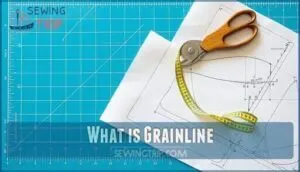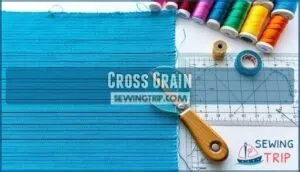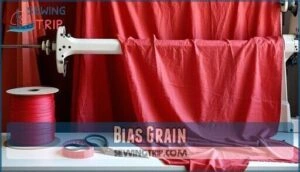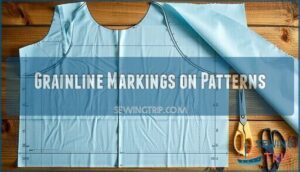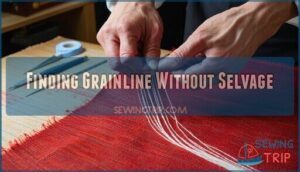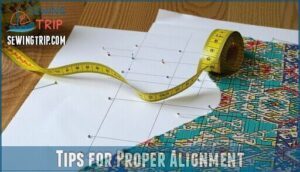This site is supported by our readers. We may earn a commission, at no cost to you, if you purchase through links.
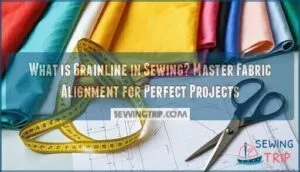
When you understand what is grainline in sewing, you’re controlling how your fabric drapes, stretches, and behaves in the finished garment.
Think of it as your fabric’s invisible roadmap – follow it correctly, and your clothes hang beautifully; ignore it, and you’ll end up with twisted, awkward-fitting pieces that never quite look right.
The grain determines whether your garment moves with you or fights against you, making proper alignment essential for professional results.
Master this fundamental concept and you’ll discover the secret to why some homemade clothes look store-bought while others scream "handmade disaster.
Table Of Contents
Key Takeaways
- You’ll ensure professional-looking garments by aligning pattern pieces with the fabric’s grainline, which controls how your clothes hang and drape naturally on your body.
- You’ll prevent twisted seams and poor fit by understanding the three grain types: straight grain (parallel to selvage) for stability, cross grain (perpendicular) for slight stretch, and bias grain (45-degree angle) for maximum flexibility.
- You’ll achieve accurate cutting by following grainline arrows on patterns and properly preparing your fabric using methods like tearing, thread-pulling, or visual alignment before placing pattern pieces.
- You’ll create garments that maintain their shape and last longer by respecting the fabric’s natural thread direction, as cutting off-grain leads to distortion and unprofessional results, affecting the overall fabric stability.
Grainline Basics
Understanding grainline is essential for creating garments that fit properly and maintain their shape over time.
When you align your fabric correctly with the grainline, you’ll guarantee your finished project drapes beautifully and wears well through countless uses, ensuring it looks great and lasts, which is crucial for garments.
Master your grainline alignment to create beautifully draping garments that maintain their shape and professional appearance through every wear.
Function of Grainline
Grainline sewing acts as your fabric’s roadmap, guiding each piece to its proper position for superior results.
When you align your sewing pattern with the fabric grain correctly, you’re setting the foundation for professional-quality garments.
Here’s what proper grainline alignment accomplishes:
- Garment Fit – Maintains clothes hang and move naturally on your body
- Fabric Drape – Maintains intended flow and fall of the material
- Structural Integrity – Prevents unwanted stretching during wear
- Professional Finish – Creates polished results that prevent distortion
Importance of Grainline
Understanding grainline sewing matters because it directly impacts your project’s success.
When you cut fabric on grain, you guarantee proper garment fit and fabric drape behaves as the pattern designer intended.
Ignoring fabric grain leads to twisted seams, poor pattern accuracy, and garments that hang awkwardly.
Proper grainline alignment creates seam stability and delivers that professional finish you’re after.
Aligning Fabric to Grainline
Before cutting fabric, verify it’s properly aligned by checking that your fabric’s straight grain runs parallel to the pattern’s grainline arrow. This fabric alignment prevents pattern matching issues and cutting challenges later.
When your material sits on grain with accurate grain positioning, you’ll avoid bias considerations that cause distortion.
Proper fabric direction alignment from the start saves time and guarantees professional results in your finished garment.
What is Grainline
When you pick up a piece of fabric, you’re holding thousands of interwoven threads that create the fabric weave.
Grainline refers to the specific fabric direction these threads follow, determining how your finished garment will hang, stretch, and maintain its shape over time.
Think of grainline as your fabric’s roadmap. The straight grain runs parallel to the selvage edges, offering maximum grainline stability and minimal stretch. Cross grain travels perpendicular to the selvage, providing moderate stretch across the fabric’s width. Bias grain cuts diagonally at 45 degrees, creating maximum stretch and beautiful garment drape.
**Grainline is your fabric’s GPS system—follow it for garments that fit beautifully and last.
Understanding fabric direction impacts everything from sewing accuracy to pattern alterations. When you align pattern pieces correctly with the grainline, you’re setting your project up for success.
Ignore it, and you’ll end up with twisted seams, poor fit, and garments that lose their shape after washing. Each grain type serves different purposes in garment construction, making grainline knowledge essential for any serious sewist.
To master this, understanding straight and bias grain is key.
Types of Grainlines
Understanding fabric grain is essential for successful sewing projects, as each type serves different purposes.
There are three main grainlines you’ll work with: straight grain, cross grain, and bias grain, each offering unique properties that affect how your finished garment looks and fits.
Straight Grain
The straight grain runs parallel to fabric’s selvage edge, following warp threads that provide maximum strength and minimal stretch.
This grain direction offers superior fabric stability for garment construction, making it perfect for structural pieces requiring cutting accuracy.
- Selvage alignment – Position pattern pieces parallel to the fabric’s finished edge
- Warp strength – Strongest grain direction with least stretch potential
- Grainline arrow – Pattern markings show proper straight grain placement
- Fabric stability – Maintains shape best when cut on straight grain
- Sewing patterns – Most pieces specify straight grain for structural integrity
Cross Grain
Cross grain runs perpendicular to the selvage edges, spanning the fabric width in the weft direction.
This crosswise strength offers slightly more grain stretch than straight grain, making it perfect for certain grain applications.
When your grainline arrow points across the woven fabric, you’re working with cross grain.
Proper fabric alignment prevents off grain cutting, ensuring your sewing tips lead to professional results.
Bias Grain
Bias grain runs diagonally across fabric at a 45-degree angle to both straight and cross grains.
This textile orientation provides maximum bias stretch and creates beautiful fabric drape that’s perfect for flowing garments.
When cutting bias, you’ll notice how fabric moves and stretches substantially more than off grain cuts.
Bias applications include bias tape, curved seams, and garments requiring flexibility.
Understanding angle importance guarantees proper fabric alignment and stability in your sewing techniques.
For precise cuts, consider using essential cutting tools to achieve professional results with maximum flexibility.
Aligning Fabric to Grain
You’ll need to align your fabric with the grain before cutting to guarantee your finished garment hangs properly and maintains its shape.
Three reliable methods can help you straighten woven fabric and prepare knit fabrics for accurate cutting.
Tearing Method
Grab your fabric firmly and make a small snip at the edge. With steady hands, tear straight across the width using controlled force.
This tearing method works best on woven cottons and linens, providing excellent tearing accuracy for fabric preparation. However, tearing limitations apply to delicate fabrics that may fray excessively.
Consider alternative methods for synthetic materials where edge quality matters most in your sewing techniques. For enhanced precision, remember to keep in mind fabric grain influence when preparing your materials, especially for tasks requiring accurate fabric cutting and understanding of fabric preparation.
Pull a Thread Method
When the tearing method proves too harsh for delicate fabrics, thread identification becomes your precision tool.
Carefully isolate a single thread near the cut edge using a pin, then gently pull it across the fabric’s width.
This method accuracy guarantees perfect fabric preparation without fabric damage, though thread length limitations may require restarting.
Ideal for suitable fabrics like fine cottons, this sewing basics technique provides reliable sewing instructions for accurate grain alignment in your sewing knowledge toolkit.
This process is known as thread-pulling for precision.
Aligning Knit Fabric
Knit fabric behaves differently than woven fabric due to its stretchy construction. You’ll need to identify the direction with the least stretch, which typically runs parallel to the ribs or wales. This becomes your lengthwise grain for pattern placement and accurate cutting.
- Knit Grain Identification: Locate the ribs or wales running vertically – this direction has minimal stretch
- Knit Fabric Stretch: Test stretch in both directions to confirm the stable grain line
- Stabilizing Knit Grain: Use pattern weights instead of pins to prevent distortion during cutting
- Bias Knit Alignment: Avoid cutting on the bias unless specifically required by pattern markings
- Cutting Knit Accurately: Keep fabric flat and use sharp rotary cutters for clean edges without pulling
Cutting on Grainline
You’ll find cutting on grainline much easier once you understand how to read pattern markings and locate the grain direction.
These essential skills guarantee your finished garments hang properly and maintain their shape through wear and washing, which is a complete concept in garment construction.
Grainline Markings on Patterns
Pattern markings serve as your roadmap for proper fabric placement.
Look for the grainline arrow—a straight line with arrowheads at both ends—printed on each pattern piece. This symbol shows you exactly how to align your fabric’s straight grain.
When adjusting grainline during pattern alterations, maintain this arrow’s direction. The arrow placement guarantees your finished garment hangs correctly and moves naturally with your body’s movements.
Proper alignment helps maintain fabric grain integrity.
Finding Grainline Without Selvage
Without the telltale selvage edges, you’ll need to become a fabric detective.
For woven materials, establish cross-grain by tearing or pulling a single thread from any cut edge to create your reference line. On delicate fabrics, use visual inspection to follow the fabric weave structure rather than relying on printed patterns.
Fabric that isn’t aligned with the fabric grainline can result in distorted garments.
For knits, trace a column of stitches using rulers for accurate pattern layout and fabric stability in your clothing design projects.
Tips for Proper Alignment
Perfect fabric preparation starts with accurate measuring and pattern matching.
Use measuring tape to verify grainline alignment matches your pattern layout requirements.
Pinning techniques support proper garment fitting and professional sewing tutorials results, and involve pinning patterns securely every 4-6 inches along grainline markings to prevent shifting during cutting precision work.
Double-check measurements before cutting to guarantee fabric stability throughout your project, and utilize a flexible measuring tool to ensure accuracy and support proper garment fitting.
Frequently Asked Questions (FAQs)
What is a Grainline in sewing?
Grainline guides your fabric cutting by showing thread direction.
You’ll align pattern pieces with the straight grain (parallel to selvage) for stability, or crosswise grain for slight stretch.
You’ll also align pattern pieces with the bias grain for maximum drape and flexibility.
What does a grainline look like?
You’ll recognize a grainline on sewing patterns as a straight line with arrows pointing in opposite directions at each end.
This visual guide shows you exactly how to align your fabric’s threads when cutting pieces.
Can grainline direction affect fabric shrinkage rates?
Picture threads dancing through fabric like tiny highways – you’ll find that grainline direction substantially affects shrinkage rates.
Lengthwise grains shrink less than crosswise grains because they’re under more tension during weaving, making fabric choice vital.
How does grainline impact garment fit alterations?
When you’re altering garments, you’ll find that grainline determines how fabric stretches and drapes, directly affecting fit adjustments.
Working against the grain can cause unwanted distortion, making alterations more challenging and less successful overall.
What causes grainline distortion during fabric manufacturing?
Manufacturing stress during weaving, dyeing, and finishing processes can pull threads out of alignment.
Tension variations, heat treatments, and mechanical handling you’ll encounter in textile production commonly distort fabric’s natural grain structure, which can be affected by various factors including tension variations.
Should grainline match when joining pattern pieces?
Getting your seams to line up like clockwork requires matching grainlines perfectly.
You’ll prevent puckering, twisting, and distortion when pattern pieces share identical grain direction, ensuring professional-looking results that hang beautifully, with identical grain direction being key to achieving this.
Can you ignore grainline for certain garments?
You can skip grainline for some garments, but it’s risky. Bias-cut pieces, draped designs, or structural elements might work, but you’ll sacrifice fit, durability, and professional appearance for most projects.
Conclusion
Mastering grainline is like learning to read your fabric’s DNA – once you understand its language, every project transforms from guesswork into precision.
Understanding what’s grainline in sewing elevates your work from amateur to professional quality.
You’ll cut with confidence, knowing your garments will drape properly and maintain their shape.
Remember to align your pattern pieces correctly, respect the fabric’s natural behavior, and take time to prepare your fabric before cutting, as these fundamentals guarantee your finished pieces look polished and wear beautifully for years.
- https://www.seamwork.com/fabric-guides/do-you-really-have-to-cut-fabric-on-the-grainline
- https://www.joannablumstudio.com/fabric-grainline-essentials-for-sewing/
- https://spoolofthread.com/pages/how-to-use-sewing-pattern-grain-lines
- https://modelistecreative.com/2018/04/03/fabric-grain-explained/
- https://www.lovenotions.com/what-is-fabric-grainline

